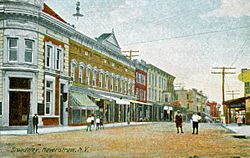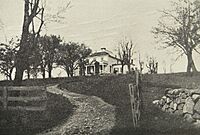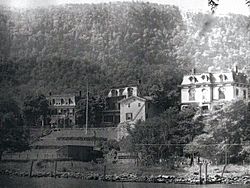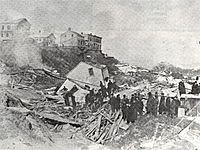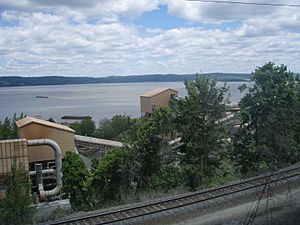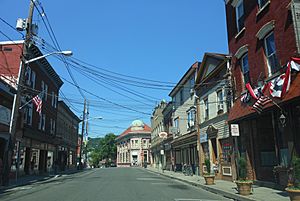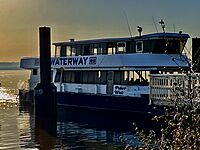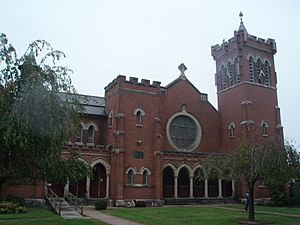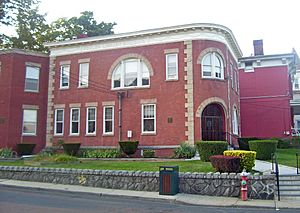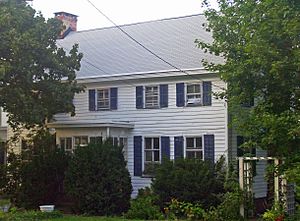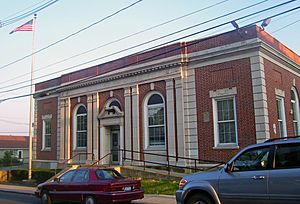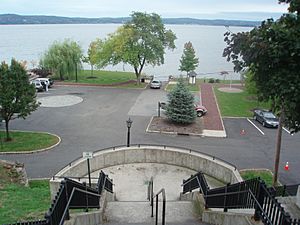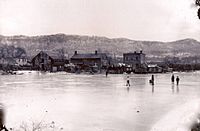Haverstraw (village), New York facts for kids
Quick facts for kids
Haverstraw, New York
|
||
|---|---|---|
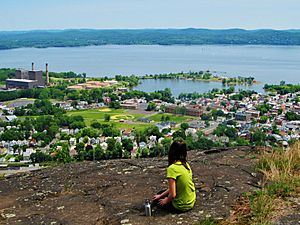
Village of Haverstraw from atop High Tor Mountain
|
||
|
||
| Nickname(s):
Bricktown, The Ville, Havi
|
||
| Motto(s):
Et Libertas Natale Solum Fumus Patriae Igne Alieno Luculentior
|
||
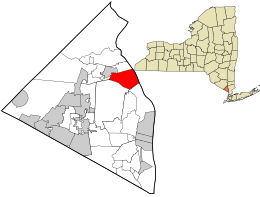
Location in Rockland County and the state of New York.
|
||
| Country | United States | |
| State | New York | |
| County | Rockland | |
| Incorporated | 1854 | |
| Area | ||
| • Total | 5.04 sq mi (13.06 km2) | |
| • Land | 1.98 sq mi (5.14 km2) | |
| • Water | 3.06 sq mi (7.92 km2) | |
| Elevation | 30 ft (9 m) | |
| Population
(2020)
|
||
| • Total | 12,323 | |
| • Density | 6,211.19/sq mi (2,398.04/km2) | |
| Time zone | UTC-5 (Eastern (EST)) | |
| • Summer (DST) | UTC-4 (EDT) | |
| ZIP code |
10927
|
|
| Area code(s) | 845 | |
| FIPS code | 36-32754 | |
| GNIS feature ID | 0952388 | |
| Website | www.voh-ny.com | |
Haverstraw is a village in Rockland County, New York, United States. It was officially made a village in 1854. Haverstraw is located north of Congers and west of the Hudson River. In 2020, about 12,323 people lived there.
The village is part of the North Rockland Central School District. It also has a Rockland Community College – Haverstraw Extension Center. As of 2009, the mayor of Haverstraw is Michael Kohut.
Contents
History of Haverstraw Village
Early Settlement and Name Changes (1609–1874)
Before Dutch settlers arrived in the early 1600s, the Rumachenanck tribe, part of the Lenape people, lived here. In 1609, Henry Hudson sailed up the Hudson River during his search for a new route to Asia.
The area first appeared on maps in 1616 as Haverstroo. This Dutch word means "oat straw." For many years, the area was part of Orangetown. But because it was growing fast and far from Tappan, it became its own area in 1719.
The village was officially formed in 1854. It was first named Warren, after Joseph Warren, a hero of the American Revolutionary War. The village was also briefly called Waynesburgh. However, people preferred the name Haverstraw. So, in 1874, the village was officially renamed Haverstraw.
Haverstraw During the American Revolution (1775–1783)
Haverstraw's location on the Hudson River made it important during the American Revolutionary War. Both the British and American armies fought battles here.
High Tor Mountain was used by the Continental Army to light watchfires. These fires helped send messages between troops along the Hudson River. Today, watchfires are lit every Memorial Day in Haverstraw. They burn for 24 hours starting at midnight on May 30.
Haverstraw was also the site of a famous act of betrayal. On September 21–22, 1780, British Major John André met with Benedict Arnold near Haverstraw. Arnold was trying to sell plans for West Point to the British. Their meeting continued at the Joshua Hett Smith House, now known as the Treason House.
Haverstraw in the American Civil War
The 95th New York Volunteer Infantry fought in the American Civil War. Company F of this group was mostly made up of men from Haverstraw. They fought in many important battles, including the Battle of Gettysburg. They also took part in Grant's Overland Campaign and the Siege of Petersburg. The infantry stayed in the war until the very end.
Haverstraw: The Brick-Making Capital
Haverstraw was known as "Bricktown" because of its huge brick-making industry. The area had special clay from the Hudson River, which was perfect for making bricks. Many buildings in New York City from the late 1800s and early 1900s were built with bricks from Haverstraw.
In the early 1900s, there were over 40 brick factories along the Hudson River in the village. Many different groups of people worked in the brickyards. About 60% of the workers were African-Americans.
Brick Manufacturers in 1910
Here are some of the brick makers in Haverstraw around 1910:
- Archer Yard No. 2
- B. J. Allison & Co.
- Bennett, Mrs. William & Sons
- Brophy & Morrissey
- C. & G. A. Archer
- D. Fowler Jr. & Co.
- DeNoyelles Brick Co.
- Dunnigan, Mrs. F. L.
- E. N. Renn & Co.
- Everett Fowler
- Excelsior Brick Co.
- F. Brophy & Brother
- Fowler & Son
- Garner Brick Works
- J. Nicholson
- James Byrnes
- L. H. Washburn
- Lynch & O'Brien
- Lynch Bros.
- Malley Brick Co.
- Morrissey & Co.
- Peck Brick Co.
- Reilly & Tanney
- Riley & Marks
- Riley & Rose
- Shankey & Morrissey
- Snedeker Bros.
- T. McGuire & Son
- T. Shankey & Son
- T. Tanney
- Tanney & Coyne
- U. F. Washburn & Co.
- Washburn & Fowler
- Wood & Allison
Later History of Haverstraw
The brick industry slowed down after World War II. This caused the village's economy to decline. Because of this, many Hispanic families moved to Haverstraw starting in the 1950s. Today, these families celebrate their heritage with annual festivals. The Puerto Rican Day Parade is in early June, and the Dominican Day Parade is in late August and September.
On January 8, 1906, a large landslide hit the village. It destroyed five blocks, 21 buildings, and took the lives of 4 firefighters and 17 residents. Despite this disaster, the village rebuilt itself. In 2007, a memorial was dedicated to the victims at Bowline Town Park.
In July 1920, baseball legend Babe Ruth visited Haverstraw to film a movie called Headin' Home. A local baseball field is named after him because of his visit.
George M. Cohan, a famous Broadway entertainer, made his first public performance in Haverstraw. His family stayed in the village during summers. Cohan was inspired by the songs of the clay diggers who worked near his home. He helped bring ragtime and jazz music to Broadway.
In September 2004, Haverstraw celebrated its 150th anniversary. The village is now working on a plan to improve its waterfront. This includes building a new community called The Harbors at Haverstraw. The state has given $3 million to help with these improvements.
In 2006, the Village of Haverstraw Police Department joined with the Town of Haverstraw Police Department to save money.
In 2012, Haverstraw was the first place in the U.S. to ban showing tobacco products in stores.
Camp Christmas Seals
Camp Christmas Seals was a special camp for children. It was open to all races and helped kids with the support of the Methodist Camp Service. Activities at the camp included boating, fishing, and swimming at Lake Tiorati in Harriman State Park.
Geography of Haverstraw
Haverstraw is on the west side of the Hudson River. Haverstraw Bay is the widest part of the Hudson River. The village is bordered by the bay and Croton-on-Hudson in Westchester County to the east.
The village has a total area of about 5.04 square miles (13.1 square kilometers). About 1.98 square miles (5.2 square kilometers) is land, and 3.06 square miles (8.0 square kilometers) is water.
Neighborhoods of Haverstraw
- Bank Corner - the downtown center
- Hahn's Corner - where Westside Avenue and Broadway meet
- South End - the new harbors community and nearby homes
- Dutchtown - near Riverside Avenue and the Hook Mountain Nyack Beach Trail
- Uptown - a fancy residential area on Hudson Avenue and Hillside Avenue
- Little Italy - around Warren Avenue and McKenzie Avenue
- Old Quarter - an older residential area on Front Street and other numbered streets
- Bull Line Blaff - on Jefferson Street and Clinton Street
- North Broadway - where Broadway meets Samsondale Avenue
- Silk Mill - between Gurnee Avenue and Spring Street
Population of Haverstraw
| Historical population | |||
|---|---|---|---|
| Census | Pop. | %± | |
| 1880 | 3,506 | — | |
| 1890 | 5,070 | 44.6% | |
| 1900 | 5,935 | 17.1% | |
| 1910 | 5,669 | −4.5% | |
| 1920 | 5,226 | −7.8% | |
| 1930 | 5,621 | 7.6% | |
| 1940 | 5,909 | 5.1% | |
| 1950 | 5,818 | −1.5% | |
| 1960 | 5,771 | −0.8% | |
| 1970 | 8,198 | 42.1% | |
| 1980 | 8,800 | 7.3% | |
| 1990 | 9,438 | 7.3% | |
| 2000 | 10,117 | 7.2% | |
| 2010 | 11,910 | 17.7% | |
| 2020 | 12,323 | 3.5% | |
| U.S. Decennial Census | |||
In 2000, there were 10,117 people living in Haverstraw. About 43.5% of households had children under 18. The average household had 3.42 people.
In 2010, the population was 11,910. Here's a breakdown of the population:
- Hispanic: 67.1%
- White: 19.3%
- Black or African American: 9.7%
- Asian: 2.2%
- Other races: 0.2%
- Two or More Races: 1.4%
Transportation in Haverstraw
A freight train line called the River Subdivision runs through Haverstraw. It's an important route for cargo trains between New York City and Albany. About 20-25 trains pass through Haverstraw each day. Passenger train service stopped in 1959.
NY Waterway runs a commuter ferry from Haverstraw to Ossining. From Ossining, people can take trains to Grand Central Terminal in New York City.
Local buses are run by Transport of Rockland. Routes #91, #95, and #97 serve Haverstraw.
Short Line buses also provide daily service. They travel along U.S. Route 9W to and from Midtown Manhattan and West Point Military Academy.
U.S. Route 9W and US 202 go right through the village. Route 9W is a popular route for cyclists. It often hosts the Gran Fondo cycling race.
Things to See and Do in Haverstraw
Historical Markers and Sites
- "Treason Site": This marker is where Benedict Arnold met Major John André in 1780. They met to discuss selling the plans for West Point. It's now at Emeline Park and Main Street.
- "Cohan's Debut": This marks the site of Waldron's Opera House, where George M. Cohan first performed. It's on Broadway and Lincoln Street.
- "Hudson River": This spot marks the widest part of the Hudson River. It's on Front/First Street and Elks Drive.
- 1906 "Great Haverstraw Landslide": This marker remembers the big landslide that happened in 1906. It's on Division and Rockland Street.
- "Brick Industry": Learn about Haverstraw's famous brick-making history at 183 West Street.
- Haverstraw Historic Site: Located at 25 Fairmount Avenue.
- Robert Fulton Clermont Steamship Berth: Where Robert Fulton's famous steamboat docked. It's at Emeline Park and Main Street.
- Site of Babe Ruth home run: This marks where Babe Ruth hit a home run during the filming of his movie. It's at Partition Street near Haverstraw Middle School.
- Central Presbyterian Church: This church has ceilings made of rare American Chestnut wood. It also has stained glass windows designed by Louis Comfort Tiffany. It's on New Main Street and Hudson Avenue.
Landmarks and Places of Interest
- Arts Alliance of Haverstraw: A center for different types of art at 91 Broadway.
- House from Edward Hopper's painting: The house from his famous painting The House By The Railroad is in Haverstraw. It also inspired the Bates' house in the movie Psycho.
- Haverstraw African American Memorial Park: This park at 41 Clinton St. tells the story of local African American history. It includes information about the African Methodist Episcopal Bethel Church, which was Rockland's first church for Black people.
- Haverstraw Brick Museum: Located at 12 Main Street, this museum shows the history of brick-making in the area.
- Haverstraw King's Daughters Village Library: This is the oldest public library in Rockland County, started in 1895. It's at 85 Main Street. The building was built with bricks from the Fowler family's brickyard.
- The Homestead: This historic house on Hudson Avenue is one of the oldest buildings in the village, built in the early 1800s.
- M/V Commander: This historic boat is at the Haverstraw Marina. It's a special example of old boat designs. You can rent it for parties and trips.
- United States Post Office (Haverstraw, New York): The post office building at 86 Main Street is also a historic site.
- St. Peter's Roman Catholic Church: Located at 115 Broadway, this is the oldest Catholic church in Rockland County.
- The Congregation of the Sons of Jacob: This is the oldest Jewish group in Rockland County, started in 1877, at 37 Clove Avenue.
Festivals and Events
Haverstraw celebrates several festivals and parades:
- Family Day Festival: Held in May.
- Farmers' Market: Every Sunday from May to November, 9:00 am to 2:00 pm.
- Italian Day Festival: Celebrated by Italian Americans in May.
- Annual Brickyard 5000 Regatta: Held every October at the Haverstraw-Ossining Ferry Landing.
Sports in Haverstraw
Haverstraw has a strong tradition in Little League Baseball and softball.
- In 2009, the Girls Little League Seniors Division team won the state championship.
- In 2010, the Girls Little League Seniors Division team won both the state and Eastern regional championships. They played in the World Series Championship in Delaware, losing to San Antonio.
- In 2014, the Boys Junior League Baseball team won the New York State Championship.
- In 2019, the Haverstraw Little League team won the New York State championship and almost made it to the Little League World Series. The girls' softball team finished third in New York State.
- In 2021, the girls' Little League Softball team won the New York state championship and went to the Little League World Series in Greenville, NC.
- In 1958, the Haverstraw Little League team won the New York state championship.
Notable People from Haverstraw
- Gerard Benderoth (1969–2017): A Haverstraw patrolman and a competitor in the World's Strongest Man contest in 2009. He was known as "The White Rhino."
- George M. Cohan (1878–1942): A famous entertainer, playwright, and composer. He is often called the "father of American musical comedy." His life was shown in the Broadway musical George M and the movie Yankee Doodle Dandy.
- Michael A. Donaldson (1884–1970): A United States Army sergeant who received the Medal of Honor for his brave actions in France during World War I.
- Derrick Lassic (born 1970): A former NFL running back.
- Toni Morrison: A famous author who won the Nobel Prize in Literature. Her novel Beloved won the 1988 Pulitzer Prize. She owns a home in the village.
Notable People Buried in Mount Repose Cemetery
- Peter Denoyelles (1766–1829): A U.S. Representative from New York.
- Ginny Gibson (1924–1998): A singer popular in the 1950s.
- Reuben L. Haskell (1878–1971): A U.S. Representative from New York.
- Lotte Lenya (1898–1981): An Austrian-born singer and actress who won a Tony Award.
- Kurt Weill (1900–1950): A German-born composer known for his stage music, including the song "Mack the Knife". He was married to Lotte Lenya.
- Leonidas Hubbard, Jr.: An explorer and writer who died during an expedition in 1903.
- Robert A. Widenmann (1852–1930): A director of the Haverstraw Light and Fuel Co. He was also a Deputy United States Marshal.
Images for kids
See also
 In Spanish: Haverstraw (villa) para niños
In Spanish: Haverstraw (villa) para niños




